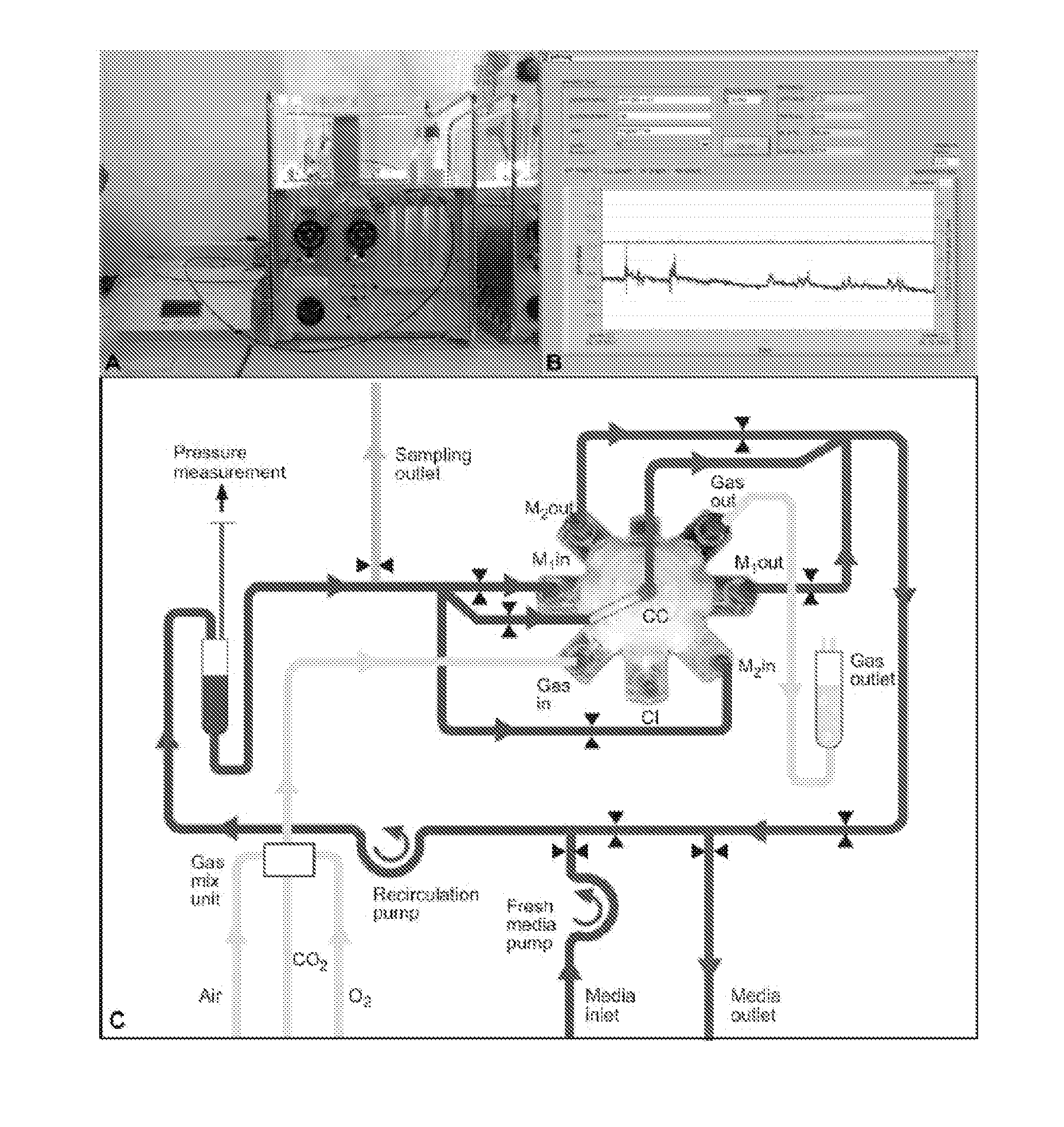3D CULTURING SYSTEMS FOR GROWTH AND DIFFERENTIATION OF HUMAN PLURIPOTENT STEM (hPS) CELLS
a technology of human pluripotent stem cells and culturing systems, which is applied in the field of 3d culturing systems, can solve the problems of inability to handle larger cell numbers, laborious 2d cultures, and limited 3d suspension culture model approaches to differentiation using aggregates or microcarriers
- Summary
- Abstract
- Description
- Claims
- Application Information
AI Technical Summary
Benefits of technology
Problems solved by technology
Method used
Image
Examples
example 1
Culture of Human Foreskin Fibroblasts (HFF)
[0115]HFF were purchased from the Type Culture Collection (CRL-2429; Manassas, Va., USA) and expanded in Iscove's Modified Dulbecco's Medium (IMDM) containing GlutaMax-1 (Invitrogen), 10% fetal calf serum and 10,000 U / 10,000 μg / ml penicillin / streptomycin (all Biochrom, Berlin, Germany) for not more than 44 population doublings. The cells were inactivated by gamma irradiation with 3000 rad and plated on 0.1% gelatin (Sigma-Aldrich)-coated culture dishes at a density of 30,000-70,000 HFFs per cm2 in VitroHES medium (Vitrolife AB, Göteborg, Sweden) supplemented with 10 ng / ml human recombinant basic fibroblast growth factor (hrbFGF) (PeproTec) or Knockout DMEM containing 20% Knockout SerumReplacer, 2 mM GlutaMax-I (all Invitrogen), 0.1 mM nonessential amino acids (NEAA), 50 μg / ml Gentamycin (all Biochrom), 0.1 mM β-mercaptoethanol (Sigma), 10 ng / ml hrbFGF (PeproTec, London, UK). Irradiated cell that were not directly used were frozen down in al...
example 2
Culture of Mouse Embryonic Fibroblasts (MEF)
[0116]MEFs were expanded in Dulbecco's modified Eagle's medium (DMEM) containing 10% fetal calf serum, 2 mM L-glutamine, 0.1 mM NEAA and 10,000 U / 10,000 μg / ml penicillin / streptomycin (all Biochrom) for 2 to a maximum of 4 passages. Inactivated by gamma irradiation with 3000 rad and seeded to 0.1% gelatin (Sigma-Aldrich) coated “In Vitro Fertilization” (IVF) dishes (Falcon, Becton Dickinson) at a density of 65,000 cell / cm2 in VitroHES medium (Vitrolife AB) or frozen down in aliquots in fetal calf serum (Biochrom) containing 10% DMSO (Sigma-Aldrich) and stored at −152° C. for later use.
example 3
The Bioreactor
[0117]The multi-compartment bioreactors used for the studies are composed of three independent, yet interwoven hollow fiber capillary membrane systems that are integrated into a two-component polyurethane housing (PUR, Morton, Bremen, Germany). Two hydrophilic capillary systems for medium perfusion are made of microporous polyethersulfone capillary membranes with a molecular weight cut-off of approximately MW 500,000 (mPES, Membrana, Wuppertal, Germany). The third one is made of hydrophobic multilaminate hollow fiber membrane capillaries (MHF, Mitsubishi, Tokyo, Japan) to enable gas exchange. The cells located within the extra-capillary space are thus exposed to decentralized medium supply with high mass exchange rates and direct membrane oxygenation via diffusion. For cell injection, a flow head and open ending silicone rubber capillaries (Silastic, Dow Corning, N.Y., USA) are used (FIG. 1A, B and C). The bioreactor is integrated into a processor controlled perfusion ...
PUM
 Login to View More
Login to View More Abstract
Description
Claims
Application Information
 Login to View More
Login to View More - R&D
- Intellectual Property
- Life Sciences
- Materials
- Tech Scout
- Unparalleled Data Quality
- Higher Quality Content
- 60% Fewer Hallucinations
Browse by: Latest US Patents, China's latest patents, Technical Efficacy Thesaurus, Application Domain, Technology Topic, Popular Technical Reports.
© 2025 PatSnap. All rights reserved.Legal|Privacy policy|Modern Slavery Act Transparency Statement|Sitemap|About US| Contact US: help@patsnap.com



